Leadership Challenges: Traits, Behaviors, and Contingency Approaches
VerifiedAdded on 2022/10/01
|11
|2057
|305
Essay
AI Summary
This essay provides a comprehensive analysis of various leadership challenges, encompassing the critical aspects of traits, behavioral theories, and contingency approaches. It begins by examining the significance of leadership traits such as honesty, optimism, and self-confidence, and how their presence or absence can impact a leader's effectiveness. The essay then delves into behavioral theories, exploring different leadership styles like authoritative, impoverished, and team management, highlighting their respective strengths and weaknesses. Furthermore, it discusses the importance of leader-member relationships and the impact of poor relationships on organizational outcomes. The essay also addresses challenges related to a leader's individual characteristics, including self-awareness, personality traits (e.g., the Big 5 personality dimensions), and the influence of values and perceptions. Lastly, it explores contingency approaches, such as the Hersey and Blanchard model and the Fiedler model, emphasizing the situational factors that affect leadership effectiveness. The essay references real-world examples, such as Martin Winterkorn's leadership at Volkswagen and the ANZ bank's leadership changes, to illustrate the practical implications of these concepts.
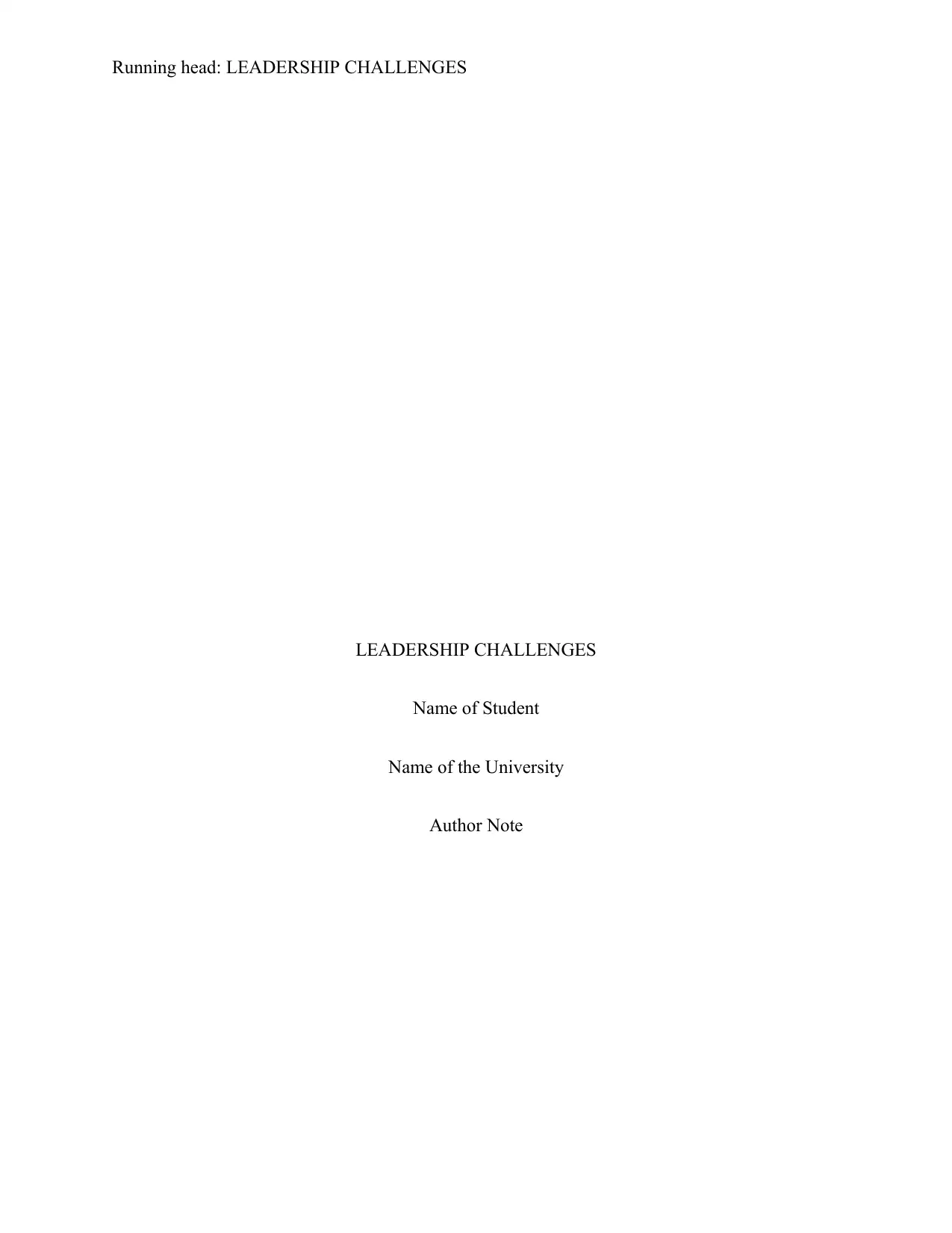
Running head: LEADERSHIP CHALLENGES
LEADERSHIP CHALLENGES
Name of Student
Name of the University
Author Note
LEADERSHIP CHALLENGES
Name of Student
Name of the University
Author Note
Paraphrase This Document
Need a fresh take? Get an instant paraphrase of this document with our AI Paraphraser
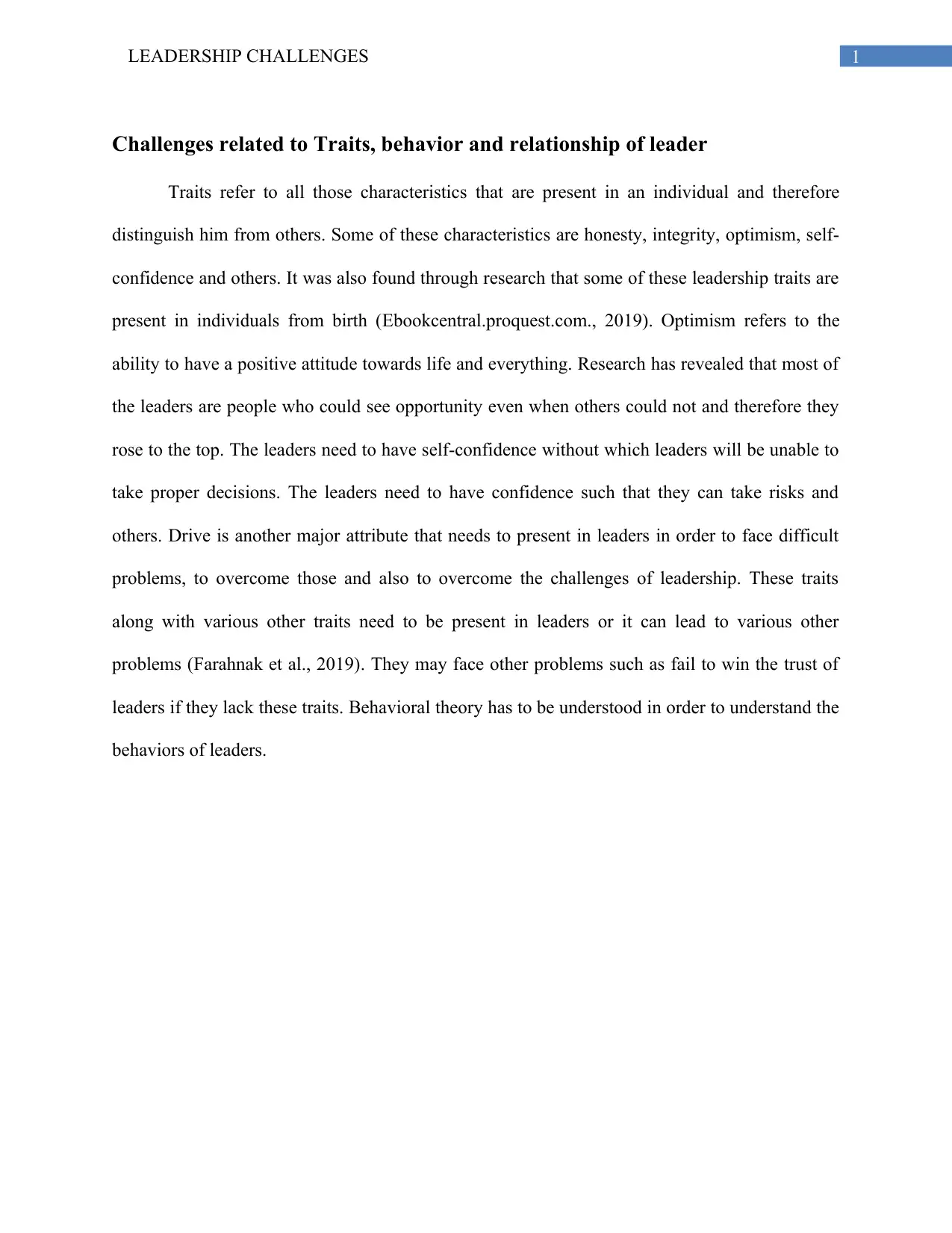
1LEADERSHIP CHALLENGES
Challenges related to Traits, behavior and relationship of leader
Traits refer to all those characteristics that are present in an individual and therefore
distinguish him from others. Some of these characteristics are honesty, integrity, optimism, self-
confidence and others. It was also found through research that some of these leadership traits are
present in individuals from birth (Ebookcentral.proquest.com., 2019). Optimism refers to the
ability to have a positive attitude towards life and everything. Research has revealed that most of
the leaders are people who could see opportunity even when others could not and therefore they
rose to the top. The leaders need to have self-confidence without which leaders will be unable to
take proper decisions. The leaders need to have confidence such that they can take risks and
others. Drive is another major attribute that needs to present in leaders in order to face difficult
problems, to overcome those and also to overcome the challenges of leadership. These traits
along with various other traits need to be present in leaders or it can lead to various other
problems (Farahnak et al., 2019). They may face other problems such as fail to win the trust of
leaders if they lack these traits. Behavioral theory has to be understood in order to understand the
behaviors of leaders.
Challenges related to Traits, behavior and relationship of leader
Traits refer to all those characteristics that are present in an individual and therefore
distinguish him from others. Some of these characteristics are honesty, integrity, optimism, self-
confidence and others. It was also found through research that some of these leadership traits are
present in individuals from birth (Ebookcentral.proquest.com., 2019). Optimism refers to the
ability to have a positive attitude towards life and everything. Research has revealed that most of
the leaders are people who could see opportunity even when others could not and therefore they
rose to the top. The leaders need to have self-confidence without which leaders will be unable to
take proper decisions. The leaders need to have confidence such that they can take risks and
others. Drive is another major attribute that needs to present in leaders in order to face difficult
problems, to overcome those and also to overcome the challenges of leadership. These traits
along with various other traits need to be present in leaders or it can lead to various other
problems (Farahnak et al., 2019). They may face other problems such as fail to win the trust of
leaders if they lack these traits. Behavioral theory has to be understood in order to understand the
behaviors of leaders.
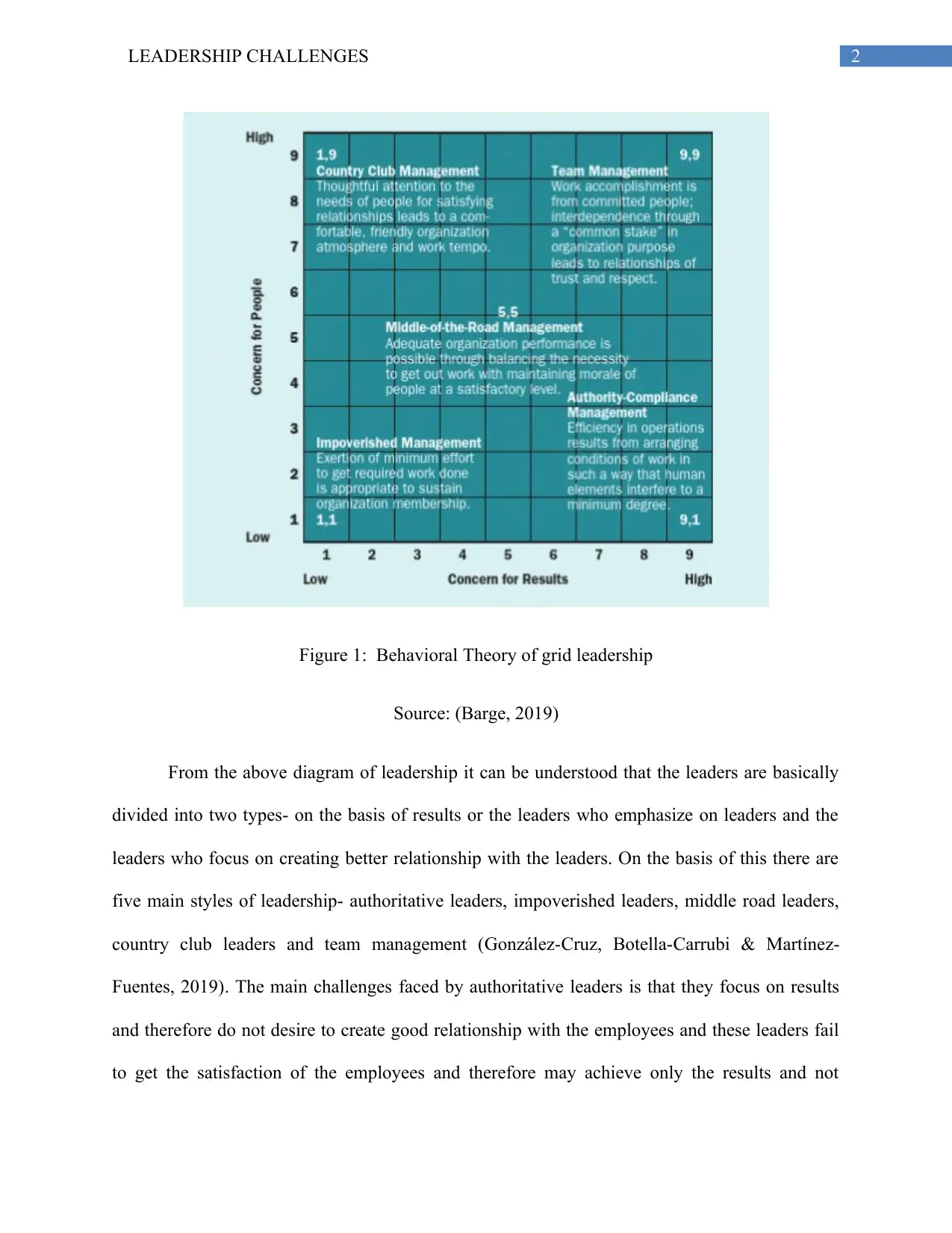
2LEADERSHIP CHALLENGES
Figure 1: Behavioral Theory of grid leadership
Source: (Barge, 2019)
From the above diagram of leadership it can be understood that the leaders are basically
divided into two types- on the basis of results or the leaders who emphasize on leaders and the
leaders who focus on creating better relationship with the leaders. On the basis of this there are
five main styles of leadership- authoritative leaders, impoverished leaders, middle road leaders,
country club leaders and team management (González-Cruz, Botella-Carrubi & Martínez-
Fuentes, 2019). The main challenges faced by authoritative leaders is that they focus on results
and therefore do not desire to create good relationship with the employees and these leaders fail
to get the satisfaction of the employees and therefore may achieve only the results and not
Figure 1: Behavioral Theory of grid leadership
Source: (Barge, 2019)
From the above diagram of leadership it can be understood that the leaders are basically
divided into two types- on the basis of results or the leaders who emphasize on leaders and the
leaders who focus on creating better relationship with the leaders. On the basis of this there are
five main styles of leadership- authoritative leaders, impoverished leaders, middle road leaders,
country club leaders and team management (González-Cruz, Botella-Carrubi & Martínez-
Fuentes, 2019). The main challenges faced by authoritative leaders is that they focus on results
and therefore do not desire to create good relationship with the employees and these leaders fail
to get the satisfaction of the employees and therefore may achieve only the results and not
⊘ This is a preview!⊘
Do you want full access?
Subscribe today to unlock all pages.

Trusted by 1+ million students worldwide
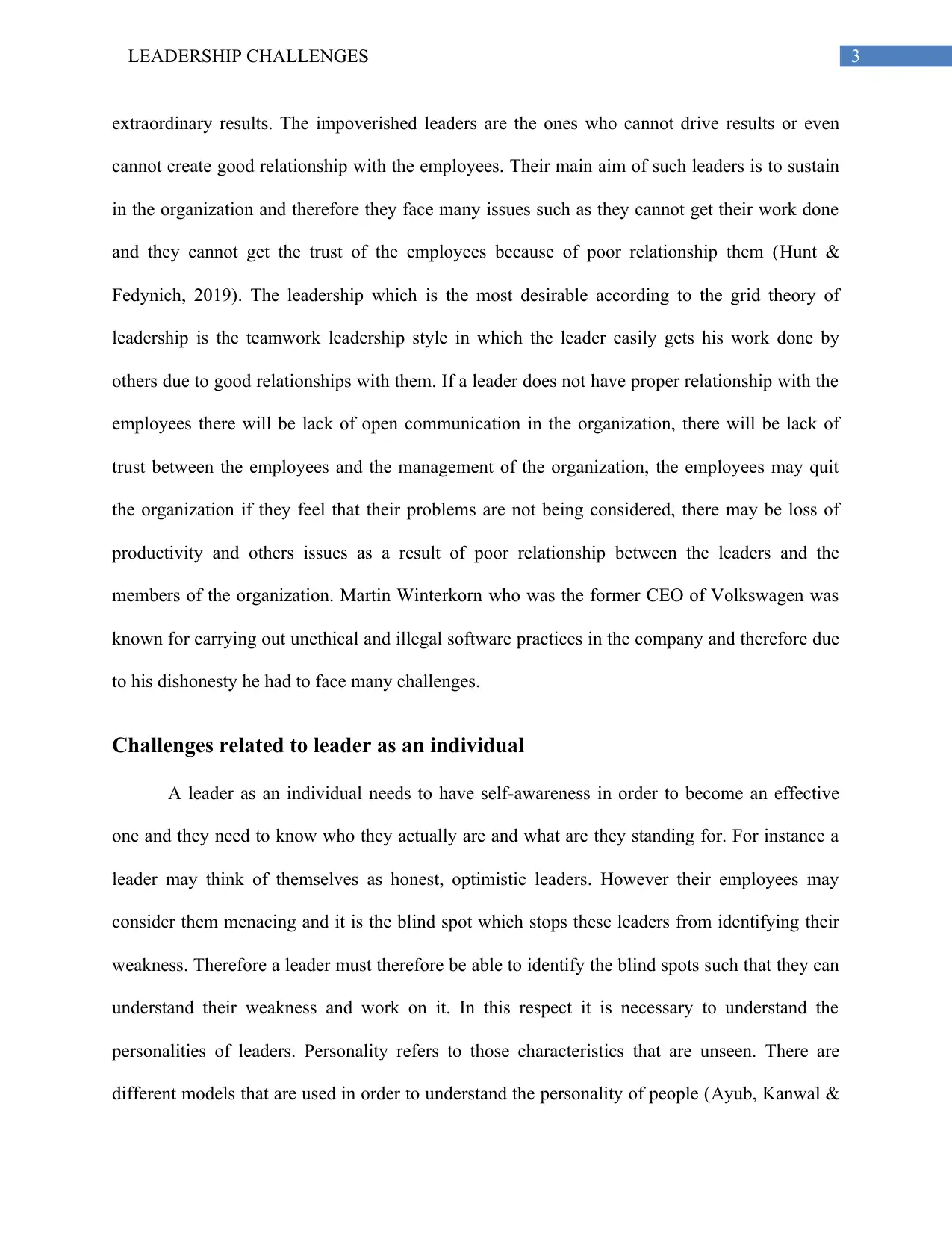
3LEADERSHIP CHALLENGES
extraordinary results. The impoverished leaders are the ones who cannot drive results or even
cannot create good relationship with the employees. Their main aim of such leaders is to sustain
in the organization and therefore they face many issues such as they cannot get their work done
and they cannot get the trust of the employees because of poor relationship them (Hunt &
Fedynich, 2019). The leadership which is the most desirable according to the grid theory of
leadership is the teamwork leadership style in which the leader easily gets his work done by
others due to good relationships with them. If a leader does not have proper relationship with the
employees there will be lack of open communication in the organization, there will be lack of
trust between the employees and the management of the organization, the employees may quit
the organization if they feel that their problems are not being considered, there may be loss of
productivity and others issues as a result of poor relationship between the leaders and the
members of the organization. Martin Winterkorn who was the former CEO of Volkswagen was
known for carrying out unethical and illegal software practices in the company and therefore due
to his dishonesty he had to face many challenges.
Challenges related to leader as an individual
A leader as an individual needs to have self-awareness in order to become an effective
one and they need to know who they actually are and what are they standing for. For instance a
leader may think of themselves as honest, optimistic leaders. However their employees may
consider them menacing and it is the blind spot which stops these leaders from identifying their
weakness. Therefore a leader must therefore be able to identify the blind spots such that they can
understand their weakness and work on it. In this respect it is necessary to understand the
personalities of leaders. Personality refers to those characteristics that are unseen. There are
different models that are used in order to understand the personality of people (Ayub, Kanwal &
extraordinary results. The impoverished leaders are the ones who cannot drive results or even
cannot create good relationship with the employees. Their main aim of such leaders is to sustain
in the organization and therefore they face many issues such as they cannot get their work done
and they cannot get the trust of the employees because of poor relationship them (Hunt &
Fedynich, 2019). The leadership which is the most desirable according to the grid theory of
leadership is the teamwork leadership style in which the leader easily gets his work done by
others due to good relationships with them. If a leader does not have proper relationship with the
employees there will be lack of open communication in the organization, there will be lack of
trust between the employees and the management of the organization, the employees may quit
the organization if they feel that their problems are not being considered, there may be loss of
productivity and others issues as a result of poor relationship between the leaders and the
members of the organization. Martin Winterkorn who was the former CEO of Volkswagen was
known for carrying out unethical and illegal software practices in the company and therefore due
to his dishonesty he had to face many challenges.
Challenges related to leader as an individual
A leader as an individual needs to have self-awareness in order to become an effective
one and they need to know who they actually are and what are they standing for. For instance a
leader may think of themselves as honest, optimistic leaders. However their employees may
consider them menacing and it is the blind spot which stops these leaders from identifying their
weakness. Therefore a leader must therefore be able to identify the blind spots such that they can
understand their weakness and work on it. In this respect it is necessary to understand the
personalities of leaders. Personality refers to those characteristics that are unseen. There are
different models that are used in order to understand the personality of people (Ayub, Kanwal &
Paraphrase This Document
Need a fresh take? Get an instant paraphrase of this document with our AI Paraphraser
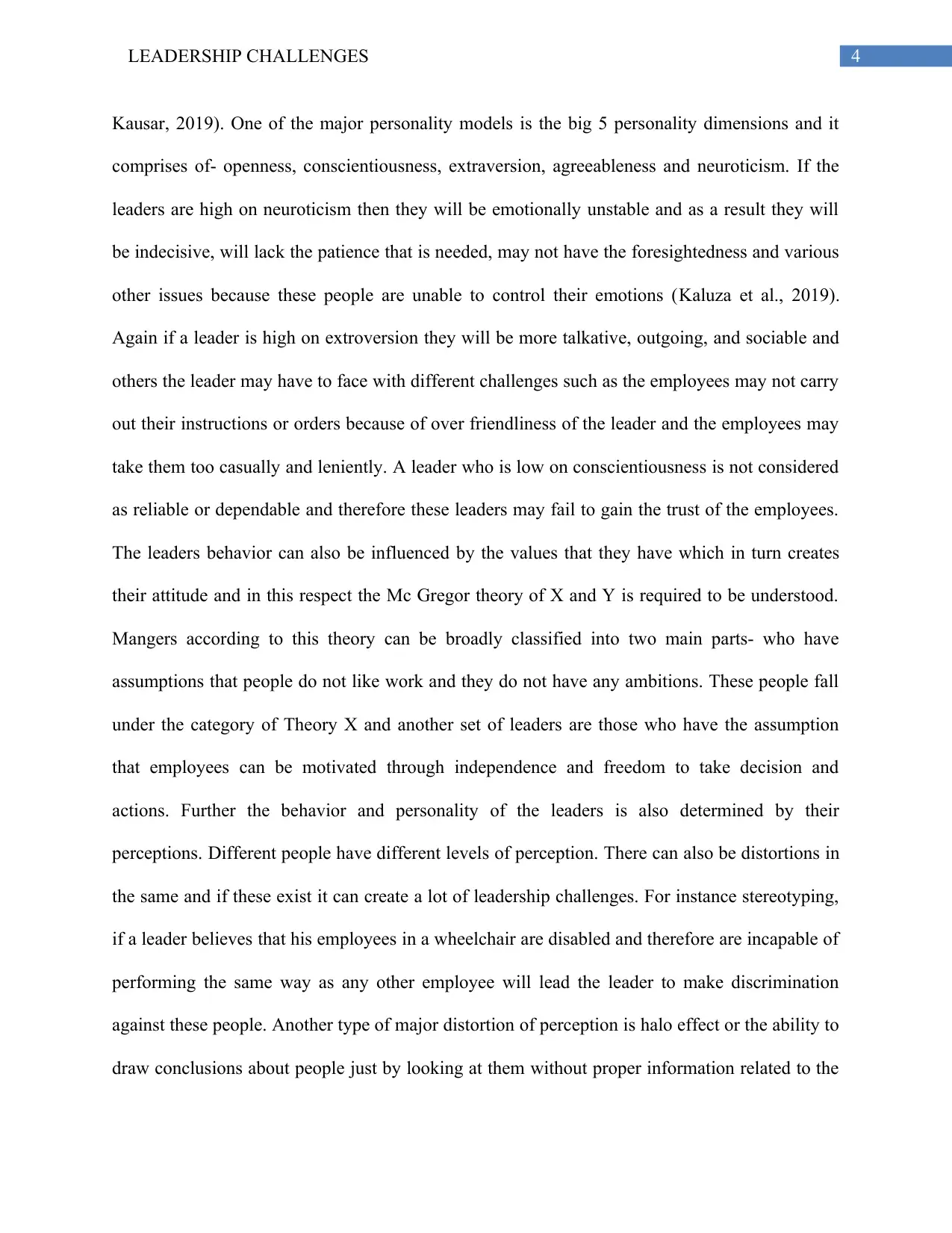
4LEADERSHIP CHALLENGES
Kausar, 2019). One of the major personality models is the big 5 personality dimensions and it
comprises of- openness, conscientiousness, extraversion, agreeableness and neuroticism. If the
leaders are high on neuroticism then they will be emotionally unstable and as a result they will
be indecisive, will lack the patience that is needed, may not have the foresightedness and various
other issues because these people are unable to control their emotions (Kaluza et al., 2019).
Again if a leader is high on extroversion they will be more talkative, outgoing, and sociable and
others the leader may have to face with different challenges such as the employees may not carry
out their instructions or orders because of over friendliness of the leader and the employees may
take them too casually and leniently. A leader who is low on conscientiousness is not considered
as reliable or dependable and therefore these leaders may fail to gain the trust of the employees.
The leaders behavior can also be influenced by the values that they have which in turn creates
their attitude and in this respect the Mc Gregor theory of X and Y is required to be understood.
Mangers according to this theory can be broadly classified into two main parts- who have
assumptions that people do not like work and they do not have any ambitions. These people fall
under the category of Theory X and another set of leaders are those who have the assumption
that employees can be motivated through independence and freedom to take decision and
actions. Further the behavior and personality of the leaders is also determined by their
perceptions. Different people have different levels of perception. There can also be distortions in
the same and if these exist it can create a lot of leadership challenges. For instance stereotyping,
if a leader believes that his employees in a wheelchair are disabled and therefore are incapable of
performing the same way as any other employee will lead the leader to make discrimination
against these people. Another type of major distortion of perception is halo effect or the ability to
draw conclusions about people just by looking at them without proper information related to the
Kausar, 2019). One of the major personality models is the big 5 personality dimensions and it
comprises of- openness, conscientiousness, extraversion, agreeableness and neuroticism. If the
leaders are high on neuroticism then they will be emotionally unstable and as a result they will
be indecisive, will lack the patience that is needed, may not have the foresightedness and various
other issues because these people are unable to control their emotions (Kaluza et al., 2019).
Again if a leader is high on extroversion they will be more talkative, outgoing, and sociable and
others the leader may have to face with different challenges such as the employees may not carry
out their instructions or orders because of over friendliness of the leader and the employees may
take them too casually and leniently. A leader who is low on conscientiousness is not considered
as reliable or dependable and therefore these leaders may fail to gain the trust of the employees.
The leaders behavior can also be influenced by the values that they have which in turn creates
their attitude and in this respect the Mc Gregor theory of X and Y is required to be understood.
Mangers according to this theory can be broadly classified into two main parts- who have
assumptions that people do not like work and they do not have any ambitions. These people fall
under the category of Theory X and another set of leaders are those who have the assumption
that employees can be motivated through independence and freedom to take decision and
actions. Further the behavior and personality of the leaders is also determined by their
perceptions. Different people have different levels of perception. There can also be distortions in
the same and if these exist it can create a lot of leadership challenges. For instance stereotyping,
if a leader believes that his employees in a wheelchair are disabled and therefore are incapable of
performing the same way as any other employee will lead the leader to make discrimination
against these people. Another type of major distortion of perception is halo effect or the ability to
draw conclusions about people just by looking at them without proper information related to the
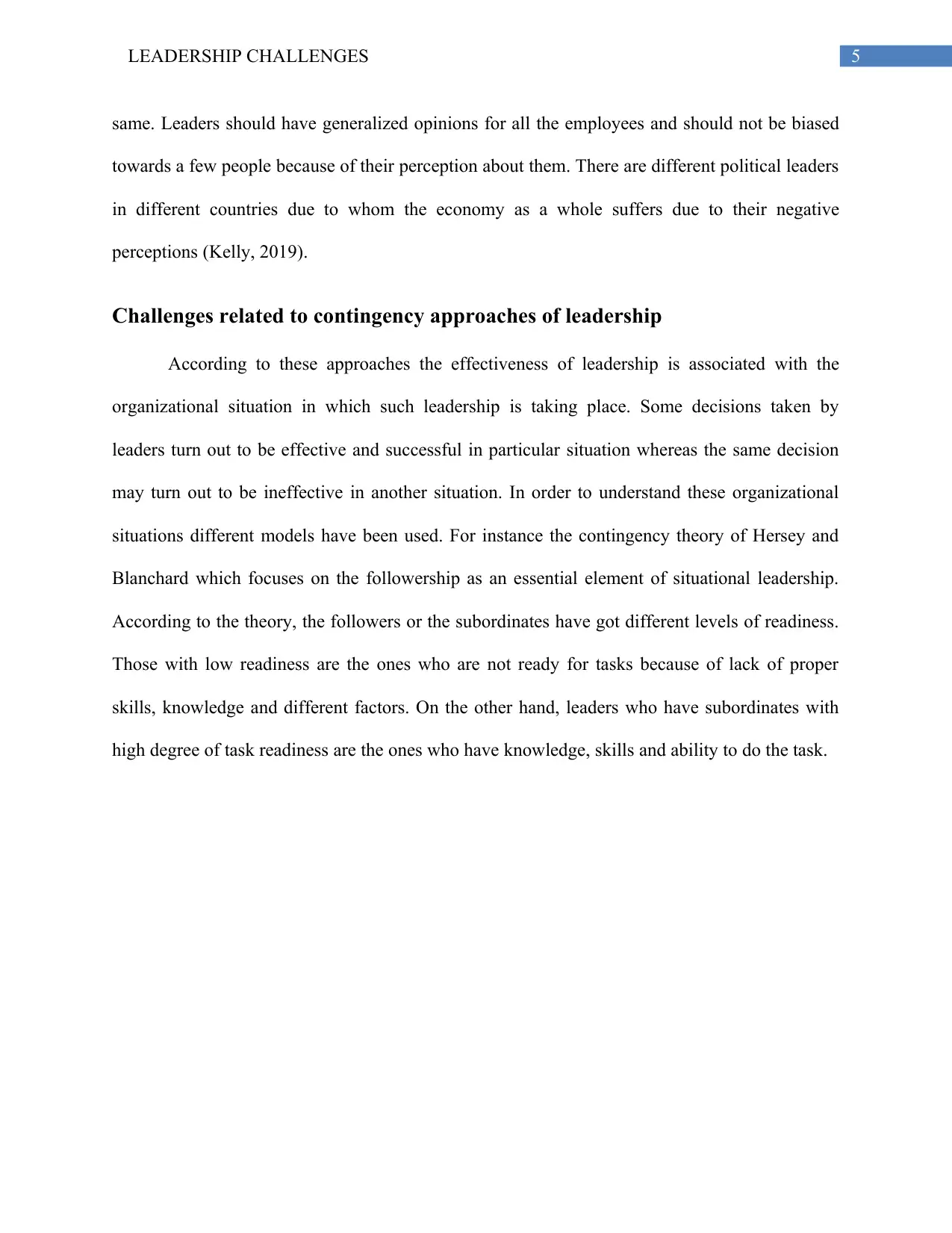
5LEADERSHIP CHALLENGES
same. Leaders should have generalized opinions for all the employees and should not be biased
towards a few people because of their perception about them. There are different political leaders
in different countries due to whom the economy as a whole suffers due to their negative
perceptions (Kelly, 2019).
Challenges related to contingency approaches of leadership
According to these approaches the effectiveness of leadership is associated with the
organizational situation in which such leadership is taking place. Some decisions taken by
leaders turn out to be effective and successful in particular situation whereas the same decision
may turn out to be ineffective in another situation. In order to understand these organizational
situations different models have been used. For instance the contingency theory of Hersey and
Blanchard which focuses on the followership as an essential element of situational leadership.
According to the theory, the followers or the subordinates have got different levels of readiness.
Those with low readiness are the ones who are not ready for tasks because of lack of proper
skills, knowledge and different factors. On the other hand, leaders who have subordinates with
high degree of task readiness are the ones who have knowledge, skills and ability to do the task.
same. Leaders should have generalized opinions for all the employees and should not be biased
towards a few people because of their perception about them. There are different political leaders
in different countries due to whom the economy as a whole suffers due to their negative
perceptions (Kelly, 2019).
Challenges related to contingency approaches of leadership
According to these approaches the effectiveness of leadership is associated with the
organizational situation in which such leadership is taking place. Some decisions taken by
leaders turn out to be effective and successful in particular situation whereas the same decision
may turn out to be ineffective in another situation. In order to understand these organizational
situations different models have been used. For instance the contingency theory of Hersey and
Blanchard which focuses on the followership as an essential element of situational leadership.
According to the theory, the followers or the subordinates have got different levels of readiness.
Those with low readiness are the ones who are not ready for tasks because of lack of proper
skills, knowledge and different factors. On the other hand, leaders who have subordinates with
high degree of task readiness are the ones who have knowledge, skills and ability to do the task.
⊘ This is a preview!⊘
Do you want full access?
Subscribe today to unlock all pages.

Trusted by 1+ million students worldwide
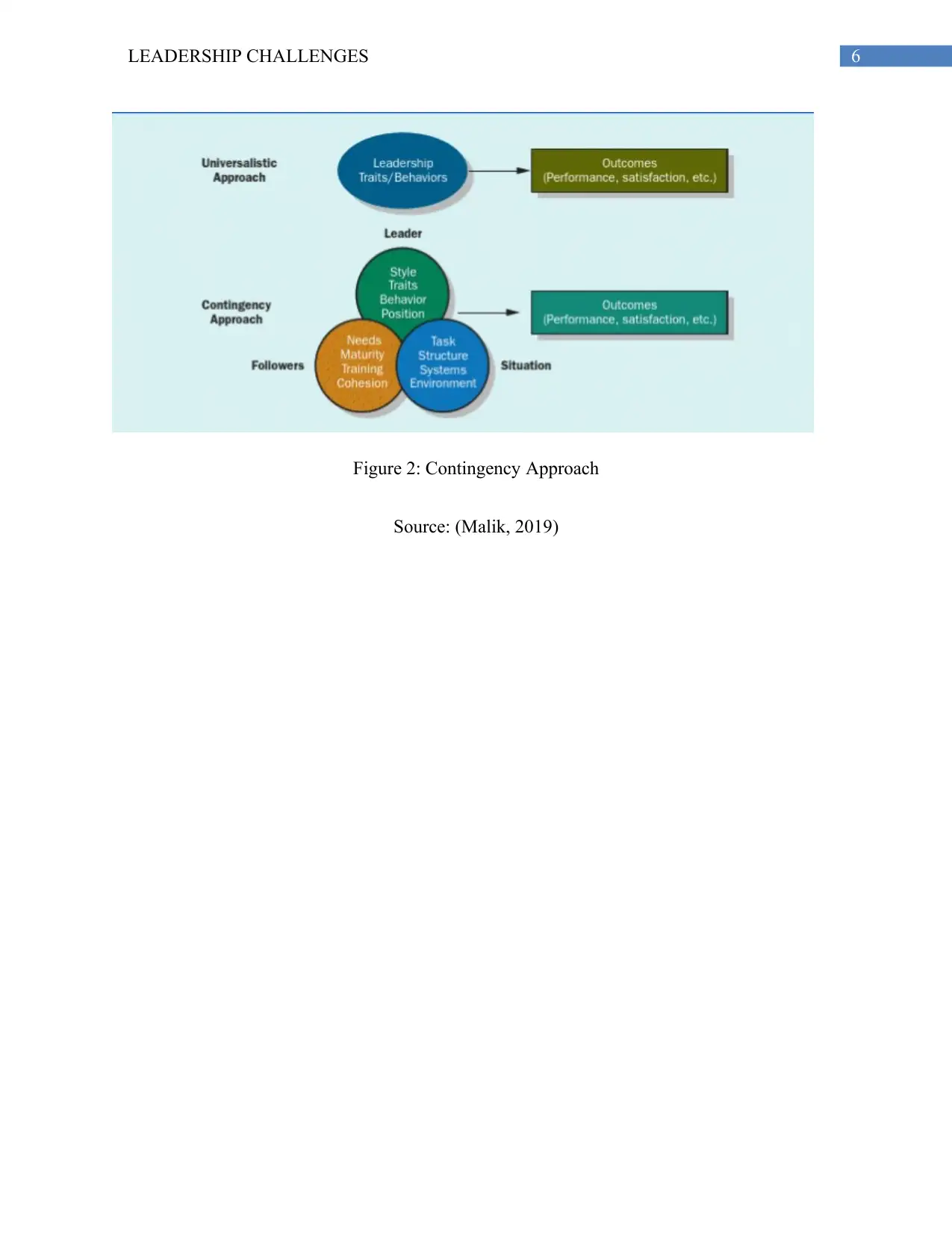
6LEADERSHIP CHALLENGES
Figure 2: Contingency Approach
Source: (Malik, 2019)
Figure 2: Contingency Approach
Source: (Malik, 2019)
Paraphrase This Document
Need a fresh take? Get an instant paraphrase of this document with our AI Paraphraser
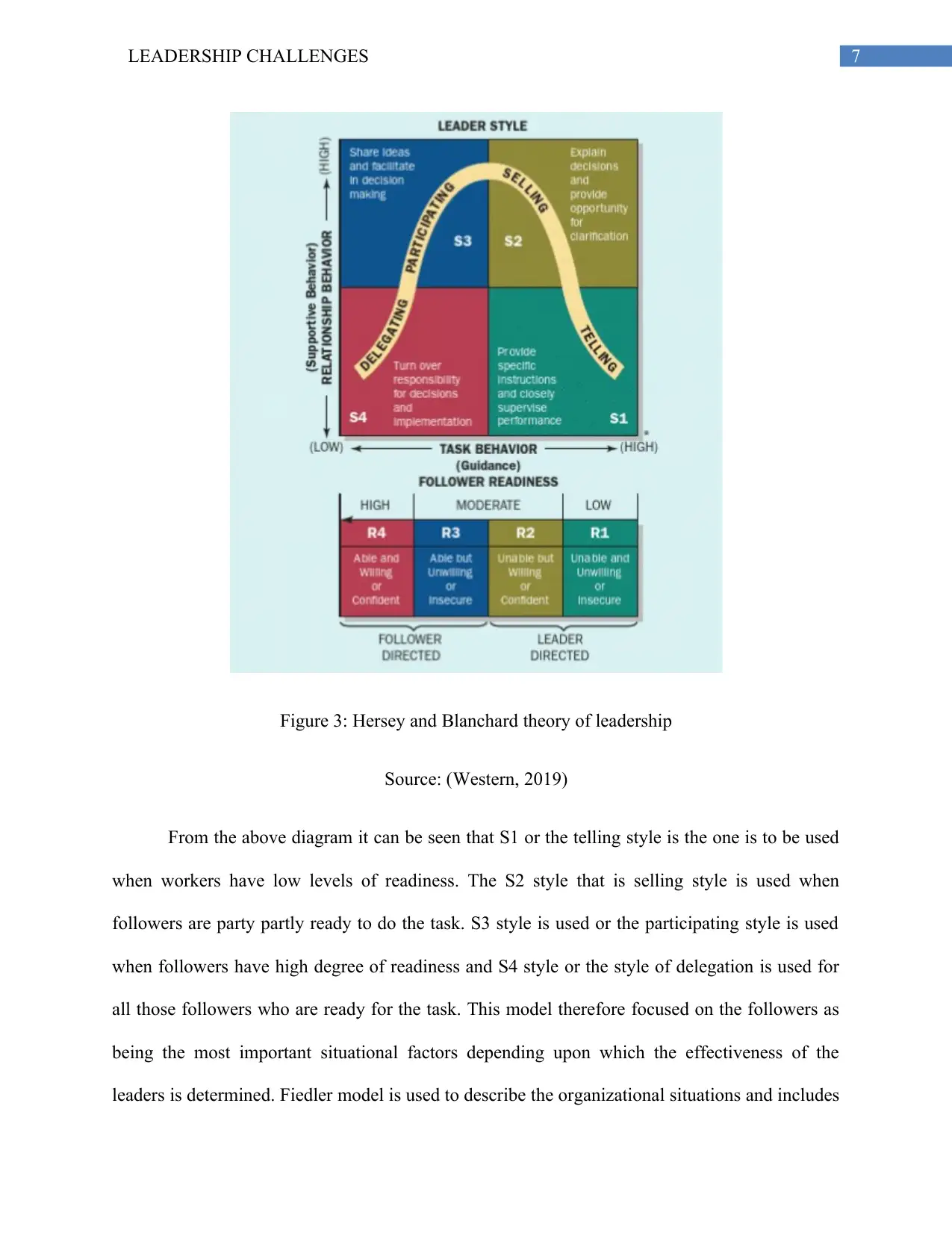
7LEADERSHIP CHALLENGES
Figure 3: Hersey and Blanchard theory of leadership
Source: (Western, 2019)
From the above diagram it can be seen that S1 or the telling style is the one is to be used
when workers have low levels of readiness. The S2 style that is selling style is used when
followers are party partly ready to do the task. S3 style is used or the participating style is used
when followers have high degree of readiness and S4 style or the style of delegation is used for
all those followers who are ready for the task. This model therefore focused on the followers as
being the most important situational factors depending upon which the effectiveness of the
leaders is determined. Fiedler model is used to describe the organizational situations and includes
Figure 3: Hersey and Blanchard theory of leadership
Source: (Western, 2019)
From the above diagram it can be seen that S1 or the telling style is the one is to be used
when workers have low levels of readiness. The S2 style that is selling style is used when
followers are party partly ready to do the task. S3 style is used or the participating style is used
when followers have high degree of readiness and S4 style or the style of delegation is used for
all those followers who are ready for the task. This model therefore focused on the followers as
being the most important situational factors depending upon which the effectiveness of the
leaders is determined. Fiedler model is used to describe the organizational situations and includes
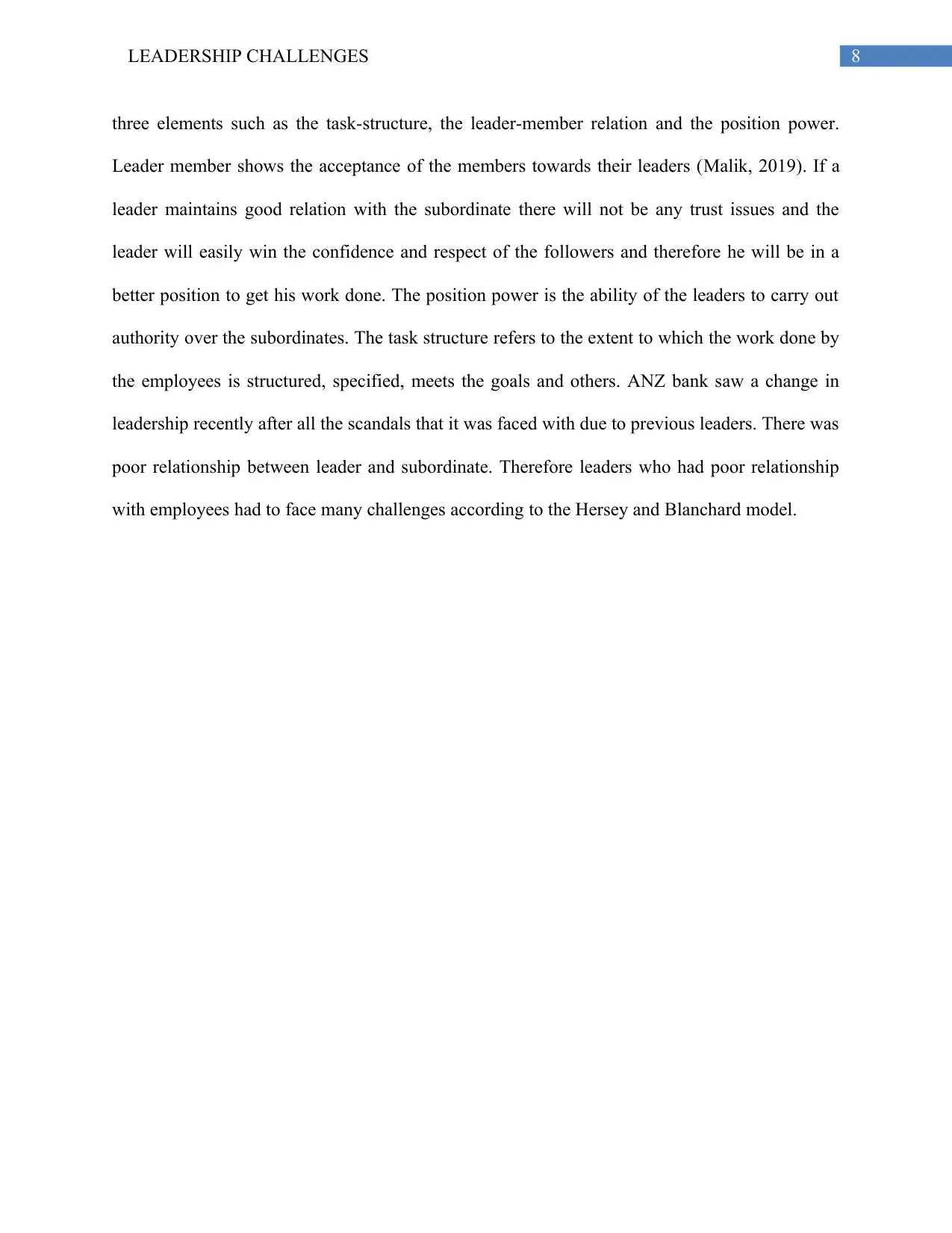
8LEADERSHIP CHALLENGES
three elements such as the task-structure, the leader-member relation and the position power.
Leader member shows the acceptance of the members towards their leaders (Malik, 2019). If a
leader maintains good relation with the subordinate there will not be any trust issues and the
leader will easily win the confidence and respect of the followers and therefore he will be in a
better position to get his work done. The position power is the ability of the leaders to carry out
authority over the subordinates. The task structure refers to the extent to which the work done by
the employees is structured, specified, meets the goals and others. ANZ bank saw a change in
leadership recently after all the scandals that it was faced with due to previous leaders. There was
poor relationship between leader and subordinate. Therefore leaders who had poor relationship
with employees had to face many challenges according to the Hersey and Blanchard model.
three elements such as the task-structure, the leader-member relation and the position power.
Leader member shows the acceptance of the members towards their leaders (Malik, 2019). If a
leader maintains good relation with the subordinate there will not be any trust issues and the
leader will easily win the confidence and respect of the followers and therefore he will be in a
better position to get his work done. The position power is the ability of the leaders to carry out
authority over the subordinates. The task structure refers to the extent to which the work done by
the employees is structured, specified, meets the goals and others. ANZ bank saw a change in
leadership recently after all the scandals that it was faced with due to previous leaders. There was
poor relationship between leader and subordinate. Therefore leaders who had poor relationship
with employees had to face many challenges according to the Hersey and Blanchard model.
⊘ This is a preview!⊘
Do you want full access?
Subscribe today to unlock all pages.

Trusted by 1+ million students worldwide
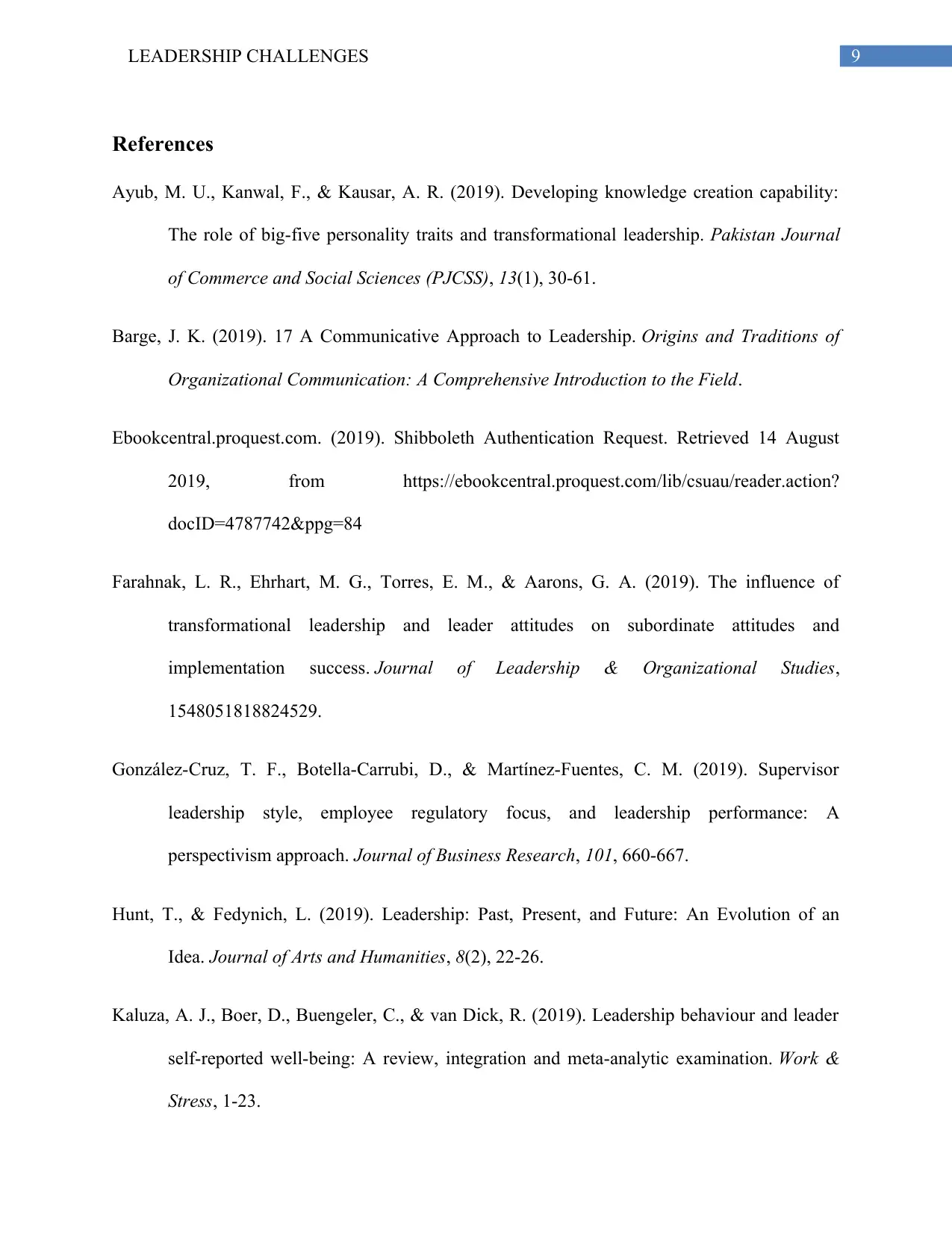
9LEADERSHIP CHALLENGES
References
Ayub, M. U., Kanwal, F., & Kausar, A. R. (2019). Developing knowledge creation capability:
The role of big-five personality traits and transformational leadership. Pakistan Journal
of Commerce and Social Sciences (PJCSS), 13(1), 30-61.
Barge, J. K. (2019). 17 A Communicative Approach to Leadership. Origins and Traditions of
Organizational Communication: A Comprehensive Introduction to the Field.
Ebookcentral.proquest.com. (2019). Shibboleth Authentication Request. Retrieved 14 August
2019, from https://ebookcentral.proquest.com/lib/csuau/reader.action?
docID=4787742&ppg=84
Farahnak, L. R., Ehrhart, M. G., Torres, E. M., & Aarons, G. A. (2019). The influence of
transformational leadership and leader attitudes on subordinate attitudes and
implementation success. Journal of Leadership & Organizational Studies,
1548051818824529.
González-Cruz, T. F., Botella-Carrubi, D., & Martínez-Fuentes, C. M. (2019). Supervisor
leadership style, employee regulatory focus, and leadership performance: A
perspectivism approach. Journal of Business Research, 101, 660-667.
Hunt, T., & Fedynich, L. (2019). Leadership: Past, Present, and Future: An Evolution of an
Idea. Journal of Arts and Humanities, 8(2), 22-26.
Kaluza, A. J., Boer, D., Buengeler, C., & van Dick, R. (2019). Leadership behaviour and leader
self-reported well-being: A review, integration and meta-analytic examination. Work &
Stress, 1-23.
References
Ayub, M. U., Kanwal, F., & Kausar, A. R. (2019). Developing knowledge creation capability:
The role of big-five personality traits and transformational leadership. Pakistan Journal
of Commerce and Social Sciences (PJCSS), 13(1), 30-61.
Barge, J. K. (2019). 17 A Communicative Approach to Leadership. Origins and Traditions of
Organizational Communication: A Comprehensive Introduction to the Field.
Ebookcentral.proquest.com. (2019). Shibboleth Authentication Request. Retrieved 14 August
2019, from https://ebookcentral.proquest.com/lib/csuau/reader.action?
docID=4787742&ppg=84
Farahnak, L. R., Ehrhart, M. G., Torres, E. M., & Aarons, G. A. (2019). The influence of
transformational leadership and leader attitudes on subordinate attitudes and
implementation success. Journal of Leadership & Organizational Studies,
1548051818824529.
González-Cruz, T. F., Botella-Carrubi, D., & Martínez-Fuentes, C. M. (2019). Supervisor
leadership style, employee regulatory focus, and leadership performance: A
perspectivism approach. Journal of Business Research, 101, 660-667.
Hunt, T., & Fedynich, L. (2019). Leadership: Past, Present, and Future: An Evolution of an
Idea. Journal of Arts and Humanities, 8(2), 22-26.
Kaluza, A. J., Boer, D., Buengeler, C., & van Dick, R. (2019). Leadership behaviour and leader
self-reported well-being: A review, integration and meta-analytic examination. Work &
Stress, 1-23.
Paraphrase This Document
Need a fresh take? Get an instant paraphrase of this document with our AI Paraphraser
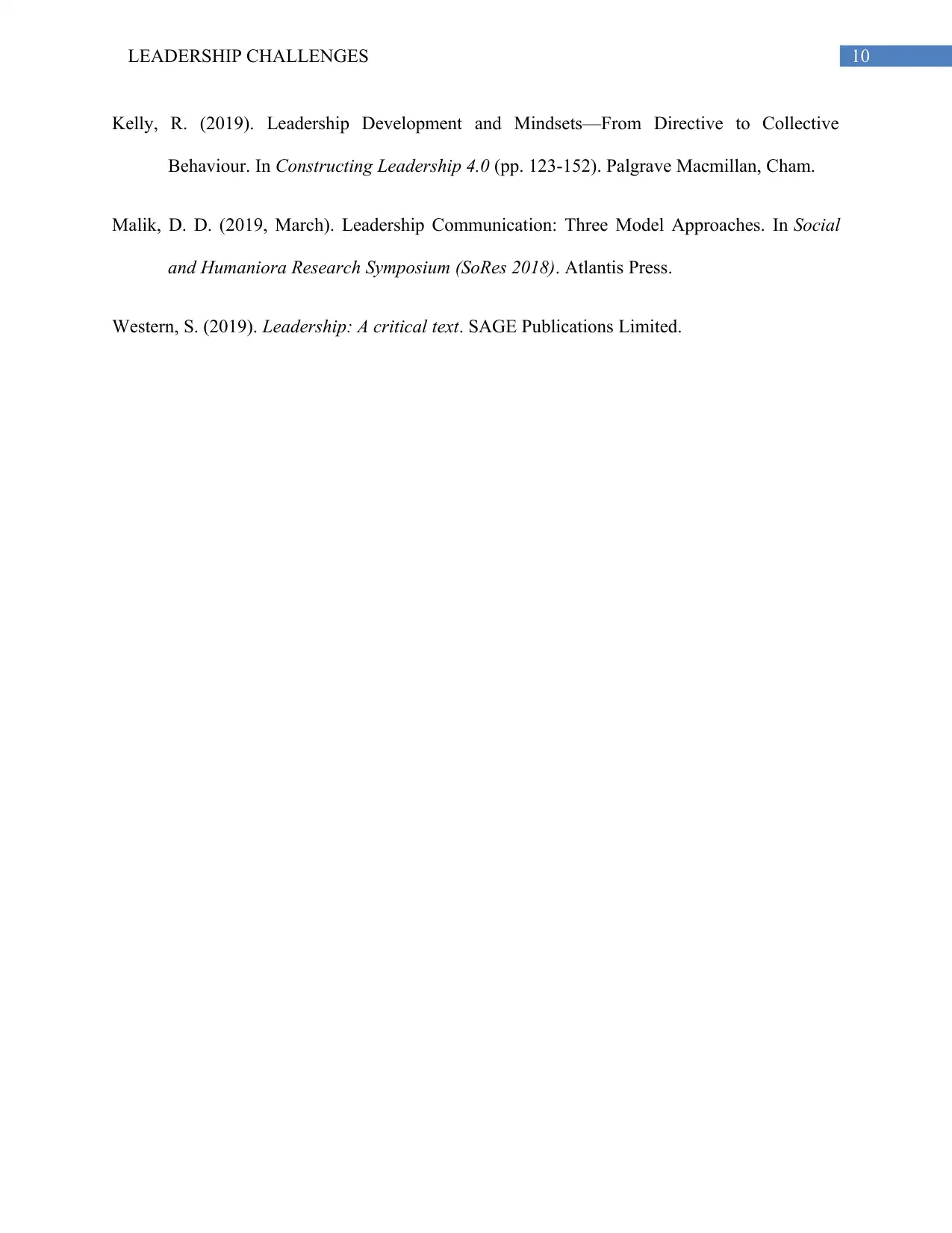
10LEADERSHIP CHALLENGES
Kelly, R. (2019). Leadership Development and Mindsets—From Directive to Collective
Behaviour. In Constructing Leadership 4.0 (pp. 123-152). Palgrave Macmillan, Cham.
Malik, D. D. (2019, March). Leadership Communication: Three Model Approaches. In Social
and Humaniora Research Symposium (SoRes 2018). Atlantis Press.
Western, S. (2019). Leadership: A critical text. SAGE Publications Limited.
Kelly, R. (2019). Leadership Development and Mindsets—From Directive to Collective
Behaviour. In Constructing Leadership 4.0 (pp. 123-152). Palgrave Macmillan, Cham.
Malik, D. D. (2019, March). Leadership Communication: Three Model Approaches. In Social
and Humaniora Research Symposium (SoRes 2018). Atlantis Press.
Western, S. (2019). Leadership: A critical text. SAGE Publications Limited.
1 out of 11
Related Documents
Your All-in-One AI-Powered Toolkit for Academic Success.
+13062052269
info@desklib.com
Available 24*7 on WhatsApp / Email
![[object Object]](/_next/static/media/star-bottom.7253800d.svg)
Unlock your academic potential
Copyright © 2020–2025 A2Z Services. All Rights Reserved. Developed and managed by ZUCOL.





